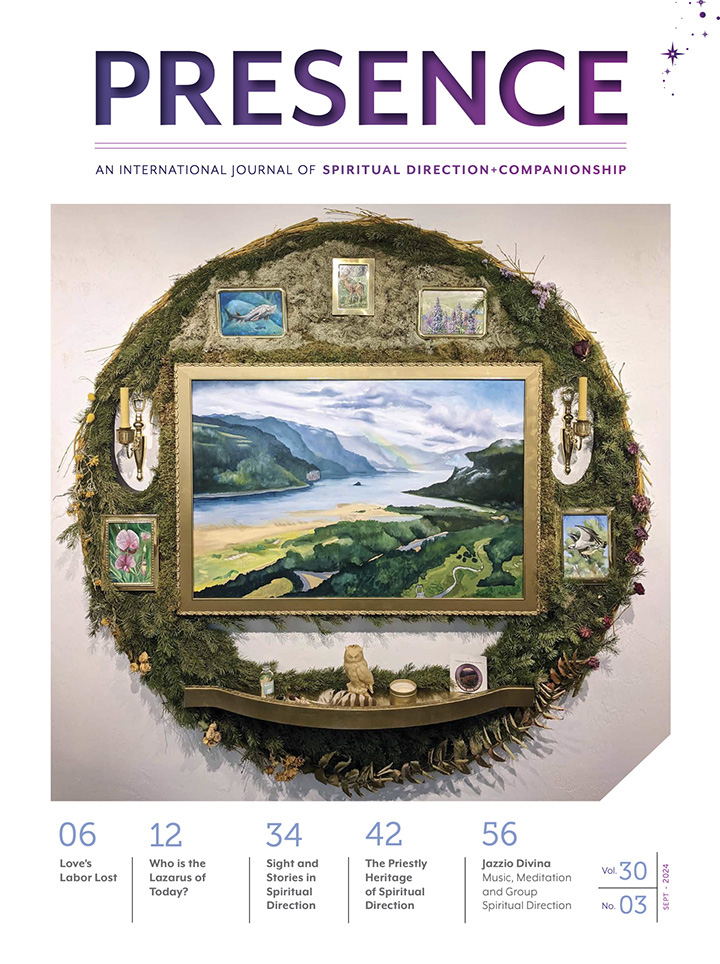By Joan Alexander
A peer can mean someone who is the same age or same social status as you, like a colleague or an associate. But to peer can also mean to look closely, with curiosity. Both of these definitions apply to Peer Supervision in Spiritual Direction. In this article I will talk about the benefits of peer supervision and give several concrete ways to organize a supervision group.
The formation of spiritual directors takes time and space, usually within an educational setting. As cohorts we gather in classroom-type environments (in person or virtually) and have access to resources such as books, presentations, and workshops. Leaders and mentors guide us along the way. We practice in role-play experiences and may go on field trips to spiritual centers and other places. Graduation from this formal type of learning is often a wonderful celebration of community… and then we go our separate ways.
Sometimes, if we are fortunate, strong connections have been made with colleagues and we continue to meet and talk together. And yet we may be cautious of how much to share about our directees. Our own insecurity about this deeply sacred work may hold us back, too.
Much of a spiritual director’s ministry is spent in isolation – mostly with one directee at a time. We listen to the whispers of Spirit and draw on resources that support and nourish these seekers and, hopefully, ourselves. If we are fortunate, we, as directors, have access to continuing education opportunities and have a faith community that encourages contemplative and other soul-nurturing practices. And yet…
- Where do we find a safe space to share wonderings and insecurities?
- How do we grow in our practice without making sessions about outcomes and fixing (for self or the seeker)?
- What do we do if we are triggered or become aware of a dual relationship by a directee’s words or actions?
- Where do we take our struggles with “going too far” and “saying the wrong thing”?
Peer supervision is the most common form of supervision for spiritual directors and spiritual companions. One-to-one sessions can be positive and supportive places in which to share and grow. Group supervision, where each member is actively practicing with one or more directee, provides a broader scope of wisdom and experience, in my opinion. Ideally, the group supervision experience with peers provides a balanced offering of self-reflection, education, and consultation.
As a trained supervision educator, I encourage groups to include at least one trained supervisor who will provide structure and guidance – certainly in the beginning stages of the group’s formation. It takes time to develop a framework that will ideally meet the needs of each member.
When people have indicated interest and commitment, it is recommended that the group schedules a planning meeting.
The planning meeting agenda may look something like this:
- Begin with a simple group building exercise, such as: craft your definition of spiritual direction with a few sentences (ideally your definition should always be changing) and share with each other.
- Schedule sessions for a one-year period (and bring your calendars).
- Schedule volunteers to present and open or close at each session.
- Select a location (virtual or in person) and coordinate who will manage things like communications and Zoom links.
- Engage in discussion and initial development of group agreements about issues of confidentiality, accountability, and so on.
- Present an overview of general group structure and model(s), by the supervisor.
Group agreements may include:
Dates & times: Monthly sessions (10-12 per year). 60 to 90 minutes each.
Members: Minimum of four – maximum of six (plus one trained supervisor).
Structure: Members take turns opening and closing each session (a short meditation, blessing or prayer).
Supervisor facilitates each session.
Members take turns offering a model (*see below for suggestions) or verbatim.
Group members ask questions for clarity.
Group members process the offering in a variety of ways (pairs and/or group).
Each member, including the presenter, articulates their learnings from the experience – about
themselves and about spiritual direction.
There are advantages to practicing in isolation. Hearing the whisper of Spirit in the silence is one. Taking time to marvel at this beautiful ministry is another. I invite you to consider how fruitful it may be to share these advantages with your peers. Think of a pie that you have prepared in the solitude of your own kitchen. As it cools, there is a knock on your door, friends enter and exclaim over the aroma. Together, you gather around the table and pass slices of pie to each one. And the conversation begins!
*Models and other resources for developing your supervision group may be found in Spiritual Direction Supervision: Principles, Practices, & Storytelling by Lucy Abbott Tucker .

Joan Alexander (she/her/hers) is a trained Spiritual Director (Haden Institute) & Supervisor (Mercy Center, Burlingame, CA, USA) with an active practice in Canada, the USA and UK. Joan is a mentor and facilitator at The Mercy Center, Burlingame, California in The Art & Practice of Spiritual Direction and Sacred Journey programs. As a supervision educator, Joan offers virtual supervision workshops that are based on the teachings of her mentor, Lucy Abbott Tucker. In addition, she co-facilitates a group supervision monthly gathering. Joan also offers virtual presentations that focus on Spiritual Direction with the LGBTQ+ Community, Spiritual Trauma and Group Spiritual Direction & Supervision. Her website is here.




